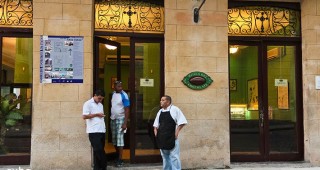The building of the railway station, expression of the Spanish plateresque style, was built in 1912 on the site of the former Armory. It has four floors with 77 windows and the main entrance is rounded off by two slender towers, whose terracotta and tile ornamentation includes the coats of arms of both the city and the nation. It used red Spanish slates for the roofs and a huge clock was featured in the center of the façade. The ground floor, which was used as waiting room, exhibits columns faced with marble. The trains entered the terminal by way of a viaduct of over one kilometer long, which has been known since as “Los Elevados” [The Elevated].

Calle San Lázaro LH  3
3
Stretching 14 blocks, this street takes its name from the San Lázaro Hospital built in 1746. It was s=successively renamed as Calle Ancha del Norte, Calle del Basurero, Avenida Antonio Maceo and Aveni …

Parroquia del Sagrado Corazón de Jesús (Parroquia del Vedado) LH  3
3
Built in 1892, this is Vedado’s oldest church; and is mostly known by its celebration of Corpus Christi in May, in addition to many other Catholic festivities. The wooden altar, pulpit and stained-gla …
 OtherOpen: 9am-5pm dailyLínea entre C y D
OtherOpen: 9am-5pm dailyLínea entre C y D 
Cruz Verde LH  3
3
The corner of Amargura and Mercaderes is known as Cruz Verde (Green Cross) due to a green-painted cross affixed to the northwest-facing cornerstone. The cross is one of twelve that were to be found al …

Alameda de Paula LH  3
3
The construction of the Alameda de Paula, one of Havana’s first promenades, was commissioned by Captain General Felipe de Fondesviela, member of the court of King Carlos III, and built by architect An …

Castillo de San Salvador de la Punta LH  3
3
Given its strategic location on one side of the harbor mouth, this fortress was one of the two most important defensive constructions in Havana’s defense system in colonial times. Construction works t …
 RenaissanceAdmission: CUC 5; free under-12sOpen: 10am-6pm Wed-SunAvenida del Puerto y Paseo de Martí (Prado)
RenaissanceAdmission: CUC 5; free under-12sOpen: 10am-6pm Wed-SunAvenida del Puerto y Paseo de Martí (Prado) 
Fuente de los Leones LH  3
3
Designed in 1836 by Italian artist Giuseppe Gaggini, the Carrara marble Fuente del Conde de Villanueva is popularly known as “Fuente de los Leones” for its four lions, one to each corner, resting on p …

Hotel Saratoga LH  3
3
The Saratoga Hotel – Reborn The oldest reference of what today is the elegant eclectic Saratoga Hotel dates back to 1879 when construction works for a three-story building began. The first floor was s …
 EclecticAdmission: Free
EclecticAdmission: Free $115 - $144ROOMS: 96Prado #603 esq. a Dragones, Habana Vieja
$115 - $144ROOMS: 96Prado #603 esq. a Dragones, Habana Vieja 
Museo del Chocolate LH  3
3
Although calling this place a museum is an overstatement, there are some intriguing artefacts relating to the history of chocolate production in Cuba. More appropriate would be to call it Café Fábrica …

Cementerio Chino LH  3
3
Chinese immigrants were promised rivers of gold on their arrival in Cuba, but in reality they were confined to barracks in abject poverty, where conditions were brutal. Many of them thought of returni …

Iglesia de Santa Rita de Casia LH  3
3
The succession of parabolic arcs made of reinforced concrete in contrast to the three stories of rectangular windows which alternate with the arcs create a sense of motion and modernity, accentuated b …
 Art DecoOpen: 9am-noon, 2-5pm Mon-Fri; 2pm-6pm Sat; 9am-noon Sun; Mass: 5:30pm Tue, Thur, Sat; 8am Wed, Fri; 10:30am Sun5ta esquina a 26
Art DecoOpen: 9am-noon, 2-5pm Mon-Fri; 2pm-6pm Sat; 9am-noon Sun; Mass: 5:30pm Tue, Thur, Sat; 8am Wed, Fri; 10:30am Sun5ta esquina a 26 


